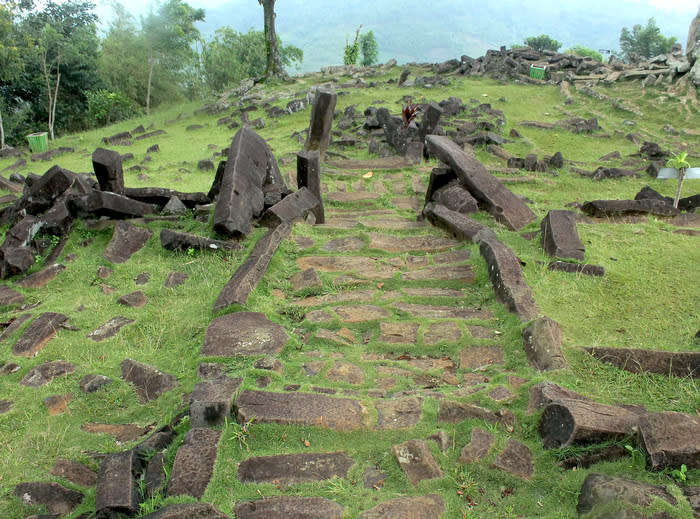A new archaeological discovery in Gunung Padang may redefine what we know about Indonesia
Archeologist Ali Akbar is living a real-life Indiana Jones adventure, busy studying soil and stone for clues about the civilization that built a structure unearthed at Gunung Padang in Cianjur regency, West Java – one that could date back to before the Common Era.
According to a Sept. 30 talk in Jakarta given by Ali -- who is part of an interdisciplinary team composed of archaeologists, architects, and paleosedimentologists who have been studying the site since 2011 -- preliminary findings date the structure to 4,500 BCE.
Should that estimate prove accurate, the structures would be older than Machu Picchu in Peru, Chichen Itza in Mexico and the pyramids in Egypt.
Though Gunung Padang has long been famous for a set of stones found near the top of Padang Hill that were believed to have been moved by humans, further examination has concluded that in fact, the hill is part of a single structure, similar to the one at Machu Picchu.
The hill stands at a height of 200 meters. By comparison, Borobudur temple in Central Java is 35 meters tall and the Great Pyramid of Giza is 139 meters in height.
The core of Gunung Padang is believed to be composed of a four-section terrace near the top of the hill. The sections further down are thought to be separate, multi-level terrace structures.
Those findings were confirmed by Ali’s team when, after excavating the second layer, they found more large stones up to four meters below the surface. Iron and stone man-made artifacts were also discovered.
Samples of the material were sent to Beta Analytic in Miami, US, for carbon dating, and the results came back suggested dating them back to between 4,700-4,500 BC. Further drilling some 14 meters down resulted in the discovery of structures believed to date back to 11,600 BC.
Even at 6,500 years old, Gunung Padang would place among the world’s top-five oldest structures, with the Mehrgarh complex in Pakistan, built sometime around 7,000 BC, being the oldest. It would be be older than the famous civilizations in Mesopotamia, Greece, Egypt and China.
The findings would also upend theories about early human history in Indonesia, where no evidence of civilization had been found prior to the 400th century, despite beliefs among many scientists that human civilization in the archipelago began much earlier.
The findings would also provide an alternative view to the consensus belief that early Indonesian societies were composed of migrants from mainland Eurasia.
“They told me humorously, ‘you might have found evidence of [the theory by] Arysio Santos’!” said Ali, referring to the scientist who authored Atlantis: The Lost Continent Finally Found, which posits that Atlantis was located in Indonesia before being wiped out by the eruption of Mount Krakatoa 11,600 years ago at the end of Pleistocene Ice Age.
Oppenheimer, who wrote Eden in the East: The Drowned Continent of Southeast Asia, holds a similar view. He theorizes that a civilization emerged in the Sundaland archipelago, but disappeared due to repetitive super-floods 14,500, 11,500, and 8,400 years ago.
Should that estimate prove accurate, the structures would be older than Machu Picchu in Peru, Chichen Itza in Mexico and the pyramids in Egypt.
Despite scattered scientific backing, the findings in Gunung Padang have elicited controversy. Several scientists have voiced criticisms, accusing the research team of improper methodology and rushing to conclusions.
For his part, Ali argues that the findings are credible, as his team is composed of scientists from a variety of fields. He adds that unlike his team’s research, earlier studies had been predominantly archaeological in nature, resulting in one-dimensional findings.
Controversies aside, Ali is pleased to have the full support of the government. Outgoing President Susilo Bambang Yudhoyono himself has repeatedly requested updates from Ali and the team, particularly on the methods being used. He has also requested that the site be uncovered and, if possible, restored.
Borobudur was also buried underground when first discovered.
In 1998, the government declared 1.7 hectares (ha) surrounding Gunung Padang a national cultural heritage site. Recent findings have convinced the Education and Culture Ministry to expand it to 29 ha starting in June of this year.
Ali said that he is not opposed to turning the site into a tourist destination, or to it being added to UNESCO’s list of World Heritage Sites.
However, he advises restraint, saying that much remains to be learned.
Read also:








